For years I had wanted to visit Tanjung Putting given its reputation as the premier site globally to get up close with Orangutans. I am happy to write that it did not disappoint and I spent 4 wonderful days in the park and one day cruising the Sekonya river, looking for other primates and birds.
Getting to Tanjung Putting is a task in itself. First you need to fly to Jakarta, Indonesia’s capital on the Island of Java. I stayed overnight here and then took a 6am flight to Semerang in central Java. I then had to wait 8 hours for a connecting flight to Pangkalan Bun in Kalimantan. Semerang airport isn’t the world’s most thrilling and I spent an exciting eight hours in a Dunkin Donuts – one of the few venues that had aircon.
Arriving in Palikan Bun, I was transported by mini van to the port of Kumai. From here I boarded a “klotok” boat with my three local crew members. The boat is of a basic design, around 30 ft long, with a central cabin area where the crew slept. Behind this room there is a small enclosed cooking area, adjacent to which, at the back of the boat, is a semi-enclosed toilet & shower area. The toilet is a non-flush one which requires bucketed river water to clear its contents. The shower uses river water, but only works when the engine is on. Most of the time, I simply used a bucket to sluice myself with river water. The top of the boat is open apart from the central area which is covered. This is where I ate my meals and slept. At night, the crew would bring up a mattress, pillow and one sheet and then erect a surprisingly effective mosquito net around the bed. Plastic awnings are pulled down at night to enclose the entire sleeping area. This is necessary to prevent getting drenched at night from tropical downpours.
Despite it being 4.30pm when I boarded the boat, the heat and especially the humidity were oppressive. Within 30 minutes, I was already pouring coffee coloured river water over my head and body in an effort to cool down and wash away what turned out to be a 5 day sweat fest.
Although the area is considerably east of Jakarta, it sits in the same time zone. Hence it gets dark at 5.30pm and light at 5am. So after only an hour cruising up the river at a leisurely pace, the light faded and helped by an absence of light pollution, the stars shone brightly. At around 6.30, we tied up to a ramshackled wooden pier and I was served dinner. The food on the boat was passable as long as you like everything fried and especially deep fried. This diet coupled with what appears to be near 100% smoking rates among all male adults made me wonder about life expectancy in Indonesia. It didn’t matter where I went on the boat, it was impossible to escape the sweet smell of local clove cigarettes.
During the first night there was a huge rainstorm accompanied by thunder and lightning. The noise of thunder and the incessant hammering of rain on the wooden roof and plastic side sheeting made sleeping difficult but I was thankful that I stayed dry. Despite the heat of the day, nights, especially after midnight, were pleasantly cool.
The next morning we were off at day break. Along the banks of the main Sekonya river, we would periodically pass troops of Proboscis monkeys and Long-Tailed macaques. I had my 600mm lens mounted on a tripod but after taking a few pictures, I eventually gave up. The boat was too noisy and unable to stop and manoever quickly to take acceptable pictures of what are for main part, extremely shy primates.
After about an hour, we turned onto a much smaller tributary. The water abruptly turned from light brown to a dark, tannin colour. I was told that up to about 10 years ago, the main river was also this colour but the influx of palm oil plantations, logging & gold mining have combined to result in a heavily polluted water way. The next two pictures show the Sekonya river tributary and the surrounding rain forest.
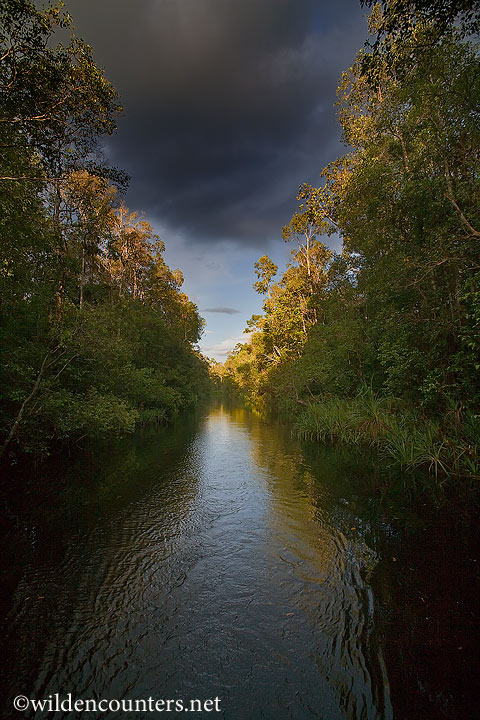
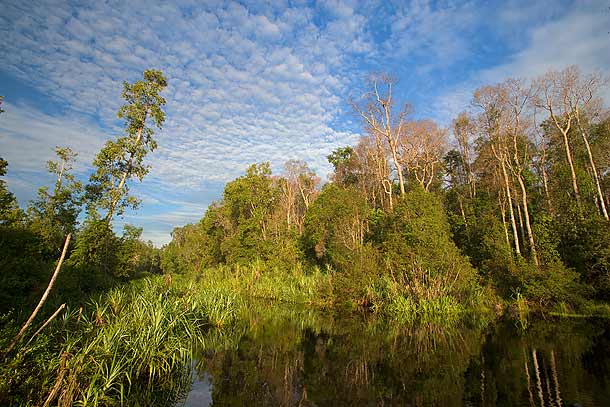
After 45 minutes on this tributary, we finally reached camp Leaky. This was where I would spend the next 4 days although at night we would retreat a few hundred meters downriver and moor up against the river bank.
Camp Leaky was established by Birute Galdikas in 1971 and is named after the famous paleontologist, Louis Leakey, who was Galdikas’ original sponsor and mentor as well as that of the two other famous primate researchers, Jane Goodall and Diane Fossey. Camp Leakey sits at the entrance to Tanjung Puting national park and is the base for the world’s longest running study of orangutans.
When Galdikas started, little was known about these elusive primates: were they social, herbivorous or frugiverous? Did they spend all their time in the trees or did they come down to the ground? How many babies did they have and how often?
Aside from the wild orangutans that populate this area, Tanjung Putting is home to a number of wild born, ex-captive orangutans rehabilitated from the early 1970s until the mid-1990s. At this latter date, a new law stopped the release of orangutans into areas with an already established wild orangutan population – the aim being to minimise competition and the risk of spreading disease.
After 45 minutes on this tributary, we finally reached camp Leaky. This was where I would spend the next 4 days although at night we would retreat a few hundred meters downriver and moor up against the river bank.
Camp Leaky was established by Birute Galdikas in 1971 and is named after the famous paleontologist, Louis Leakey, who was Galdikas’ original sponsor and mentor as well as that of the two other famous primate researchers, Jane Goodall and Diane Fossey. Camp Leakey sits at the entrance to Tanjung Puting national park and is the base for the world’s longest running study of orangutans.
When Galdikas started, little was known about these elusive primates: were they social, herbivorous or frugiverous? Did they spend all their time in the trees or did they come down to the ground? How many babies did they have and how often?
Aside from the wild orangutans that populate this area, Tanjung Putting is home to a number of wild born, ex-captive orangutans rehabilitated from the early 1970s until the mid-1990s. At this latter date, a new law stopped the release of orangutans into areas with an already established wild orangutan population – the aim being to minimise competition and the risk of spreading disease.
When Galdikas first came to Indonesia, it was common for Indonesians to keep orangutans, especially juveniles and babies, as pets. Aside from her research goals, she also wanted to create a refuge for orphaned orangutans. In the early 1970s, she carried out her first confiscation of a baby orangutan. So as not to place any stress on the wild orangutan population, supplemental feedings have been made available for ex-captives. As I witnessed, sometimes 1-2 show up at the feeding station; sometimes 5-6.
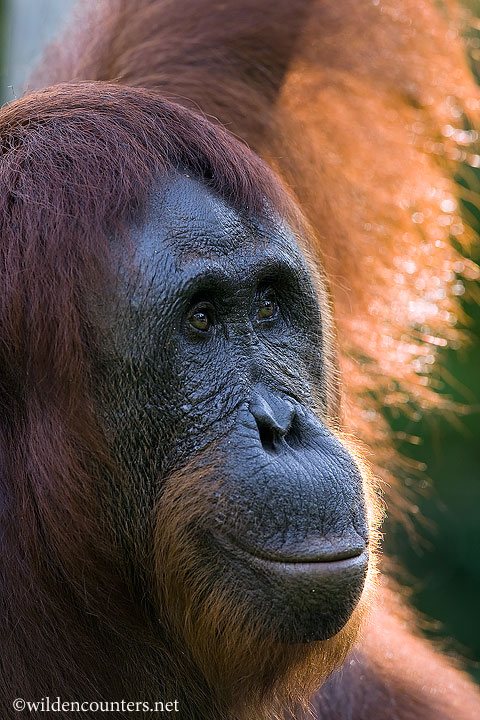
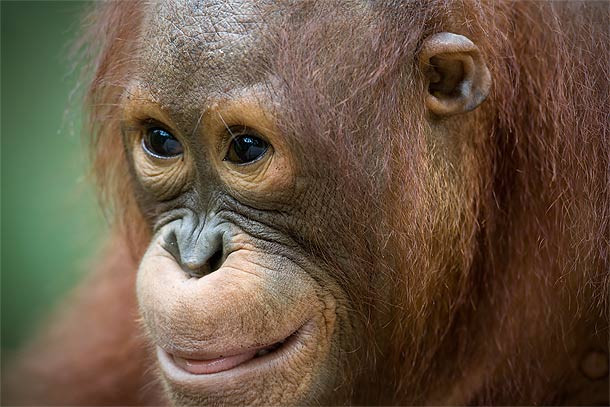
Orangutan is derived from the Malay/Indonesian words for “person” (orang) and “forest” (hutan). They can live for over 50 years with males growing up to 5ft and weighing 120kgs whereas females are smaller, reaching 4ft and 45kgs. However, when you get up close to them, even the females appear to be a lot bigger.
While it is possible to photograph the orangutans at the daily feeding sessions, I wanted images in a more natural setting so I stuck to the forest areas, often venturing off-path. Most of the orangutans in the camp Leakey area are either ex-captive or descendents of ex-captive orangutans. They are very comfortable with humans and it is possible to get extremely close. However, certain individuals are known to be more aggressive than others and one needs to be vigilant during these close encounters. I was twice chased and was subject to several mock charges accompanied by exaggerated gaping. During the time I was there, a western research volunteer was bitten quite badly.
But by getting close and shooting with a wide-angle lens and an off-camera flash at its lowest setting, I was able to produce what I think are a collection of intimate images which also show the environment in which these amazing creatures live.
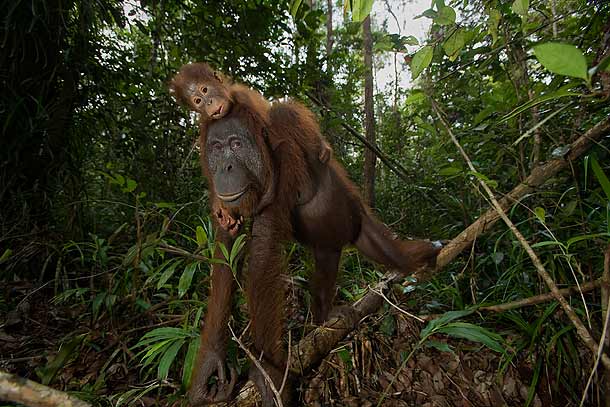
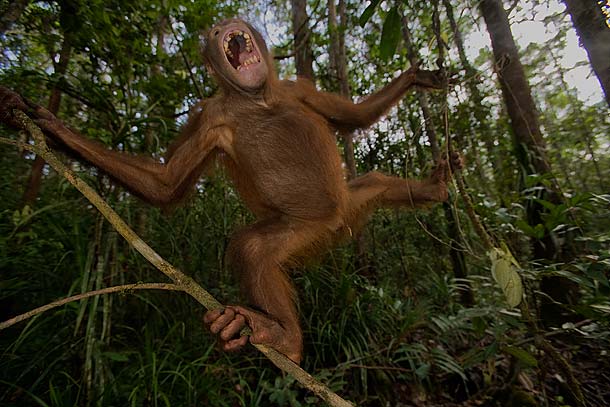
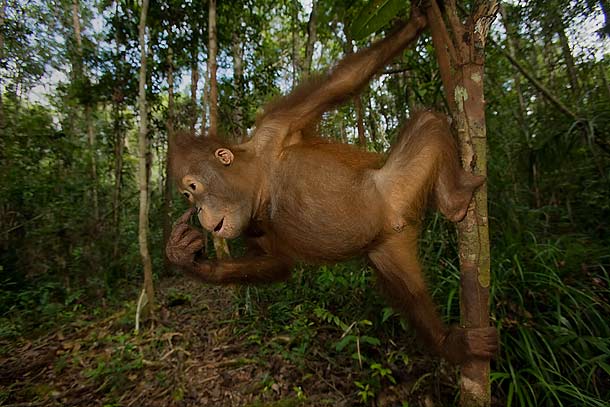
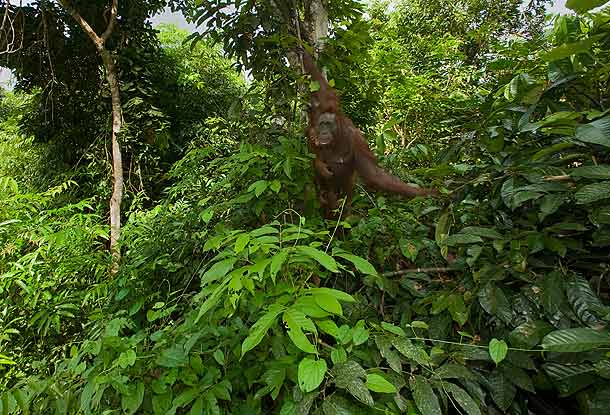
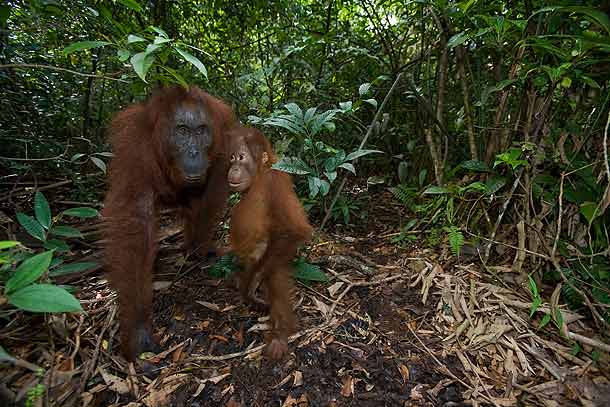
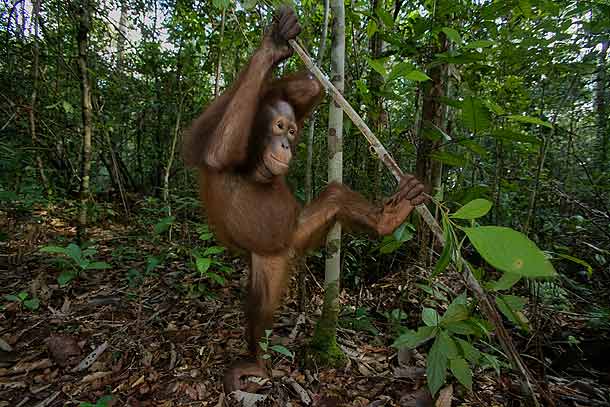
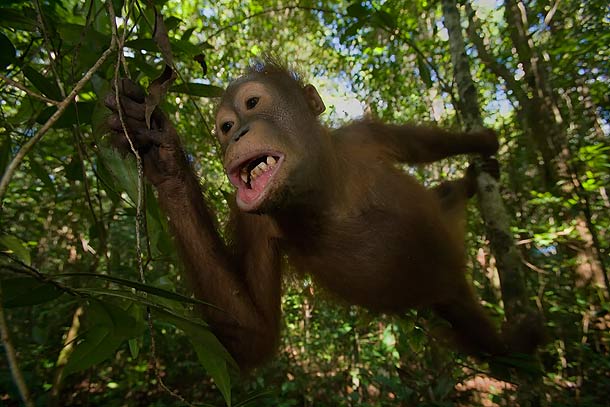
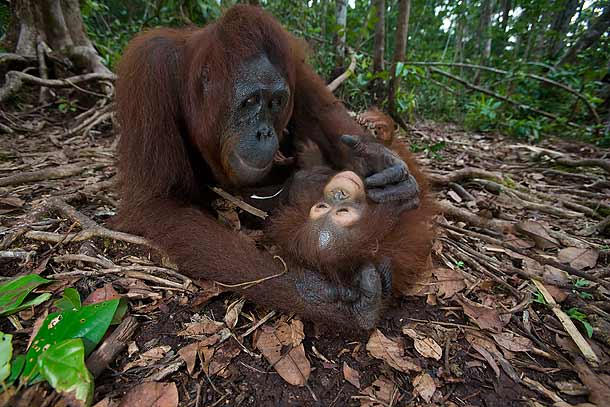
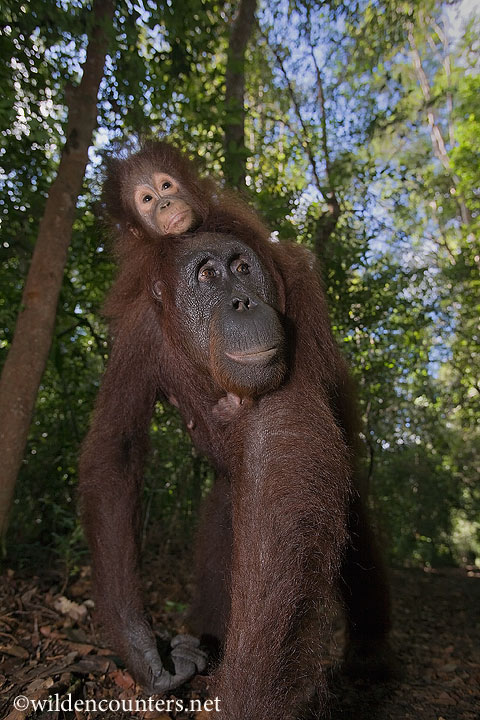
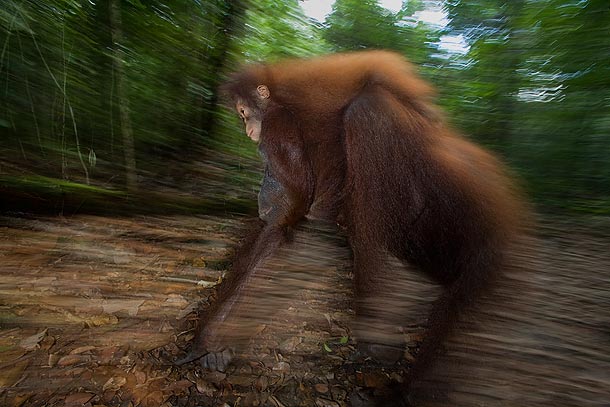
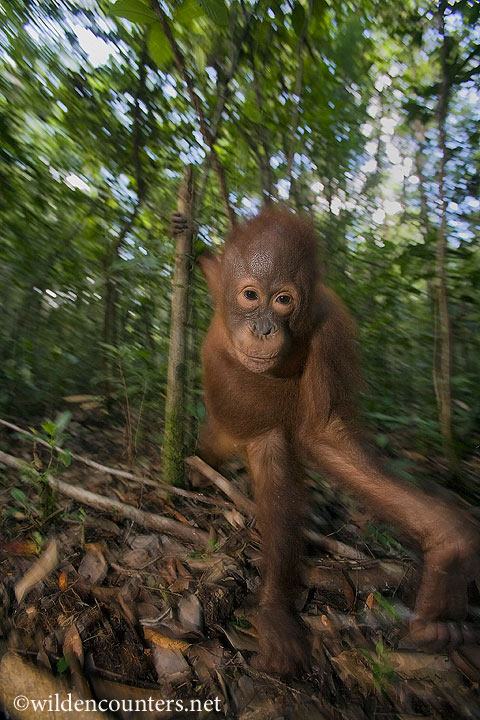
Orangutans, which are only found in Indonesia and Malaysia (Borneo), face a precarious future. Habitat loss is the most significant threat to Orangutan. Logging and gold mining are major culprits, but in the last 15 years the biggest offender has been palm oil plantations.
Palm oil is the 2nd most consumed edible oil globally after soyabean oil and Malaysia and Indonesia account for 90% of the world’s supply.
The total area occupied by palm oil in Indonesia has doubled in the last 10 years and of the 6.5m hectares of palm oil plantation across Sumatra and Borneo, almost 4m hectares has replaced rainforest.
In the last 40 years, Indonesia has lost 40m hectares of forest equivalent to the combined size of Germany & Holland. Palm oil companies commonly use fire to clear plantation land. Three quarters of the 1997/1998 fires were started by palm oil companies. And here’s a truly shocking statistic: one huge fire during this period destroyed one-third of Borneo’s orangutan population with more than 20,000 orangutans dying.
I’ve heard all the arguments about bio-fuels, but when you read these statistics and think about the plight of the orangutans, you have to believe that the price is too high. But it’s not just the orangutans that are suffering.
– Monoculture plantations result in massive forest destruction.
– Indigenous people lose their land and traditional land practices when plantations take over.
– Plantation work in SE Asia often pays below the minimum wage.
– Bribery and corruption are associated with the expansion of plantations.
Palm oil plantations surround Tanjung Putting national park and have already begun to encroach inside the park’s boundries.
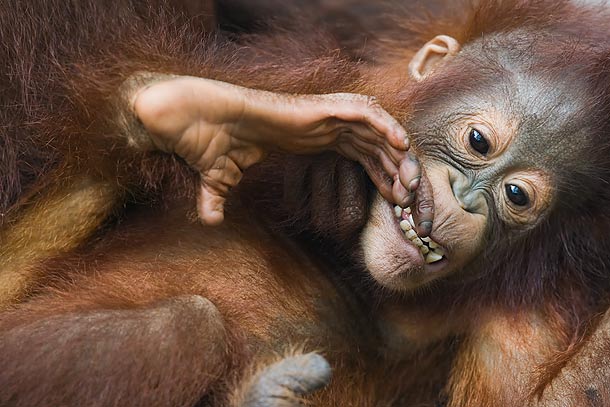
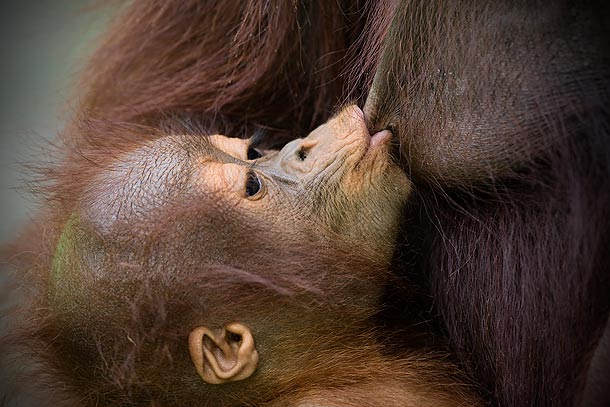
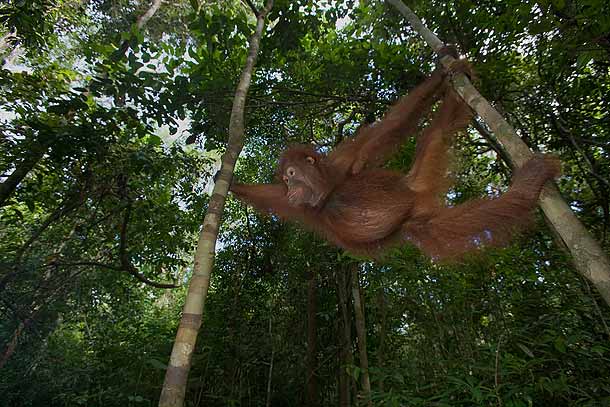
Borneo (including Kalimantan) is home to 5,000 tree species compared to just 34 native species in England. Tanjung Putting National Park is home to 220 species of birds, 17 species of reptiles and 29 species of mammels. Of the latter, aside from the orangutans, I saw forest hogs, barking deer and two other primates, shown below: Black-Handed gibbons and Proboscis monkeys.

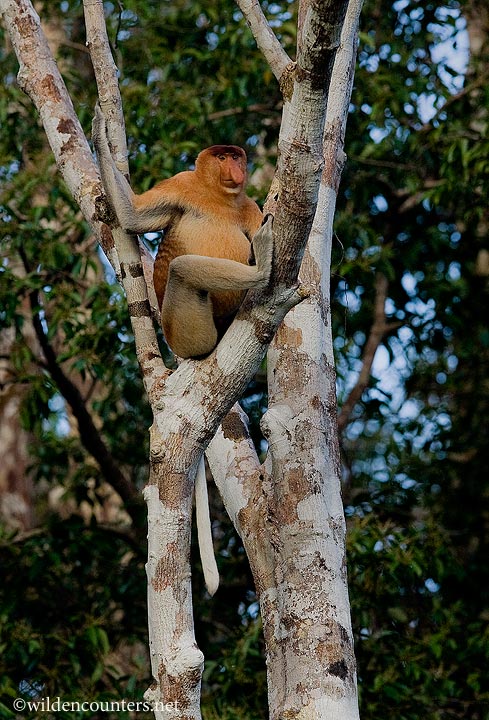
Despite my crew’s claim that they were all devout muslims, they had no problem knocking back a few Bintangs (Indonesian beer) on the last night. Bintang + rain forest photography generally do not mix well.
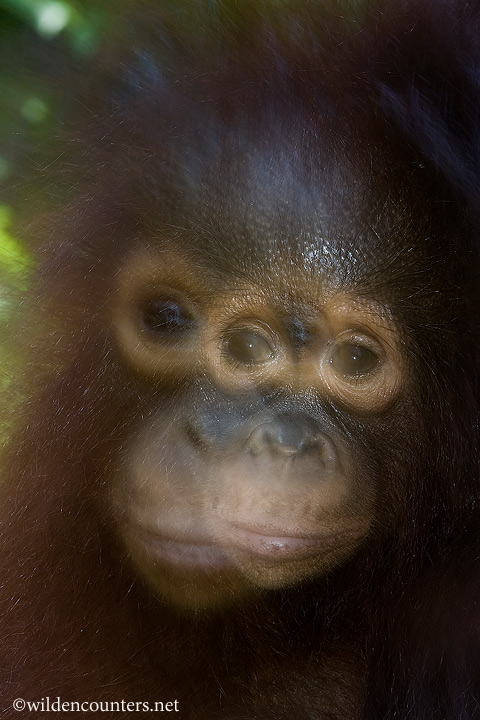
Gopi Kumar
March 16, 2010
Fantastic photos. The forest fire that killed over 20 000 OT’s was shocking news to me. I hope we humans will wake up to the fact that this world belongs to all of us, animals and plants and we learn to co-exist.
Paul Mckenzie
March 22, 2010
Yup – you are spot on. When it comes to the protection of endangered species, or lack thereof, China and Indonesia really stand out as culprits both in Asia and globally.